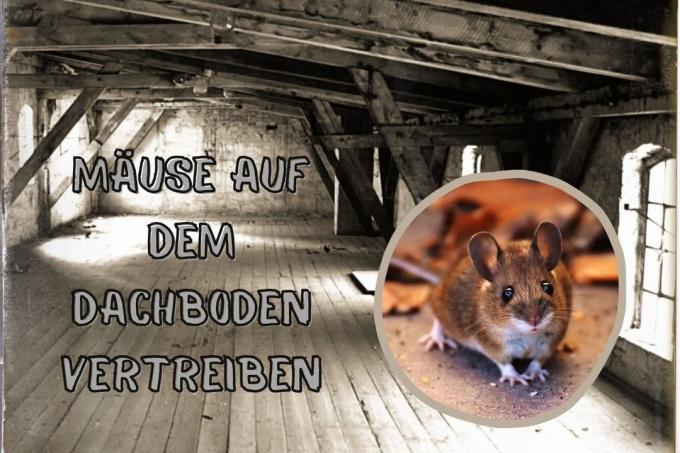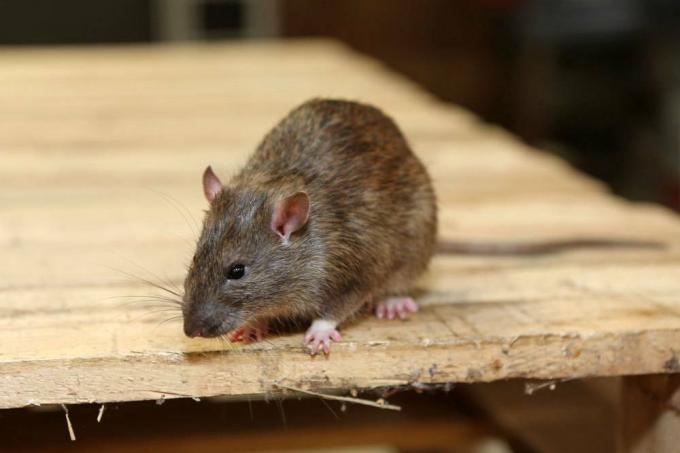
table of contents
- Predators
- Odorant
- Noises and movements
- light
- Prevent renewed infestation
- frequently asked Questions
Chasing away mice in the attic can be very easy with the right tools and measures. We show what is important here.
In a nutshell
- Odorants are usually only effective for a short time
- Noises can be used to drive away
- Movements and controls prevent infestation and damage
- other means should be used in addition to distribution
- Traps and prevention of re-infestation often prove necessary
Predators
Cats and dogs that are allowed to move freely in the attic can drive away mice comparatively easily and quickly. If you have the appropriate pets, you can use them to drive them away.
However, this variant also has potential problems and disadvantages. These include:

- Contagion with diseases
- Ingestion of toxins when the mice have ingested them elsewhere
- The hunting instinct is strengthened
- Transmission of parasites such as fleas, mites or worms
Tip: If the dog or cat is frequently in the affected areas, the smell and the noises can already have a driving effect.
Odorant
If you find traces of a mouse infestation, odor agents can be used. Examples of possible signs include:
- Feces
- Holes in walls or boxes
- Signs of gnawing on various surfaces
- Urine smell
In some cases, noises can also be heard if the house is very noisy. However, you can rarely see the shy animals directly. If you discover such traces, you should look for the building. From here, tracks can often be followed relatively easily. This is important, on the one hand, to get rid of the rodents odor and, on the other hand, to have a deterrent effect.
The following guide can help you do this efficiently:

- Finding traces: With a black light lamp you can safely find the urine residues and other DNA traces. It is crucial that the room is darkened.
- Cleaning: To remove the traces, disinfectants and enzyme cleaners can be used. Experience has shown that it makes sense to use both agents and then carry out another check with the black light. Otherwise, it may be tagged again and more mice will be attracted.
- In order to drive mice out of the attic, deterrent odor sources can be introduced afterwards. For example:
- brushed fur from dogs and cats
- used cat litter
- chlorine
- cloths soaked in turpentine
Tip: You can stuff the odorants directly into the exit holes of the buildings and apply them to the gnaw marks. However, the rodents get used to it over time if neither dogs nor cats are around. These agents only work for a short time and should therefore only be used in combination with other measures.
Noises and movements
The more often you go to the attic and check it for mice, the more uncomfortable it will be for you. Walking around and possibly playing music or loud conversations have a deterrent effect and can drive the rodents away.
Regular checks of the attic and the installation of a radio do not usually work immediately, but can prove to be very efficient. In addition, these measures are inexpensive and easy to implement. Special ultrasound devices represent a special form of noise. They generate a high-frequency sound that is supposed to scare away the animals and keep them away.
However, various problems and potential disadvantages arise with such devices.

- In the long run, the mice can get used to the clay
- ongoing costs from power consumption or batteries
- Sound can also disturb other animals or people
- comparatively expensive to buy
Modern variants should no longer bother people, but young people in particular, but also pets, can perceive the noise and find it unpleasant.
light
Mice are not necessarily nocturnal, but prefer darker areas such as an attic. If this is done again and again and the light is switched on, that also has a deterrent effect.
Alternatively, you can attach lamps in conjunction with motion detectors. The motion detectors should be at floor level and placed exactly where the animals' tracks can be found.
Tip: Cameras with lighting and motion detectors can, on the one hand, be a deterrent because of the light and, on the other hand, show whether it really is Mus musculus or other animals.
Prevent renewed infestation
To prevent re-infestation with mice or other animals, some measures should be taken. The following tips will help drive away the rodents and keep them away:

- Keep order: On the one hand, neatly stowed boxes and boxes make it possible to identify damage quickly. They make regular checks easier and offer fewer hiding places for the animals.
- Lock entrances: The entrances to the buildings but also to the attic should be searched for and locked. This prevents more mice from following and the roof becomes unattractive as a place to stay for the rodents.
- Perform controls: Regular checks help to identify traces at an early stage and to be able to keep damage to a minimum. This means that action can be taken quickly and contamination can be avoided as well as damage to the insulation, the walls and the floor.
frequently asked Questions
As a rule, these areas are used less often and offer the rodents protection from the elements and predators. This makes them an ideal shelter for entire families of mice, just like garden houses or sheds.
In addition, these rooms are often used as storage and therefore offer numerous hiding spots.
Poisoned mice can often retreat to their burrows to die. If they die in the wall, it is an enormous odor nuisance. In addition, insects can be attracted to the smell of putrefaction.
The traps do not keep the mice away, but they can be an aid. As soon as the animals have been caught and released far away, possible entry gates can be closed.
